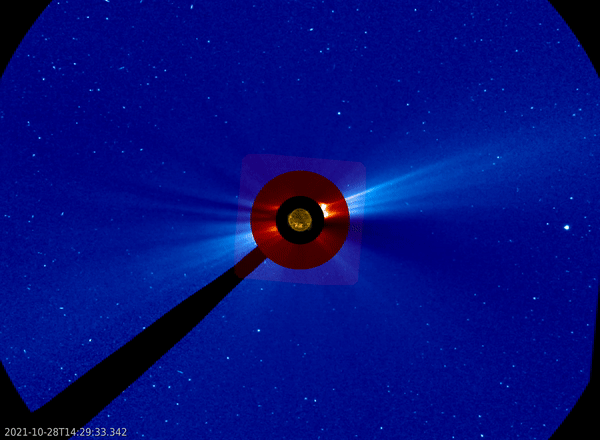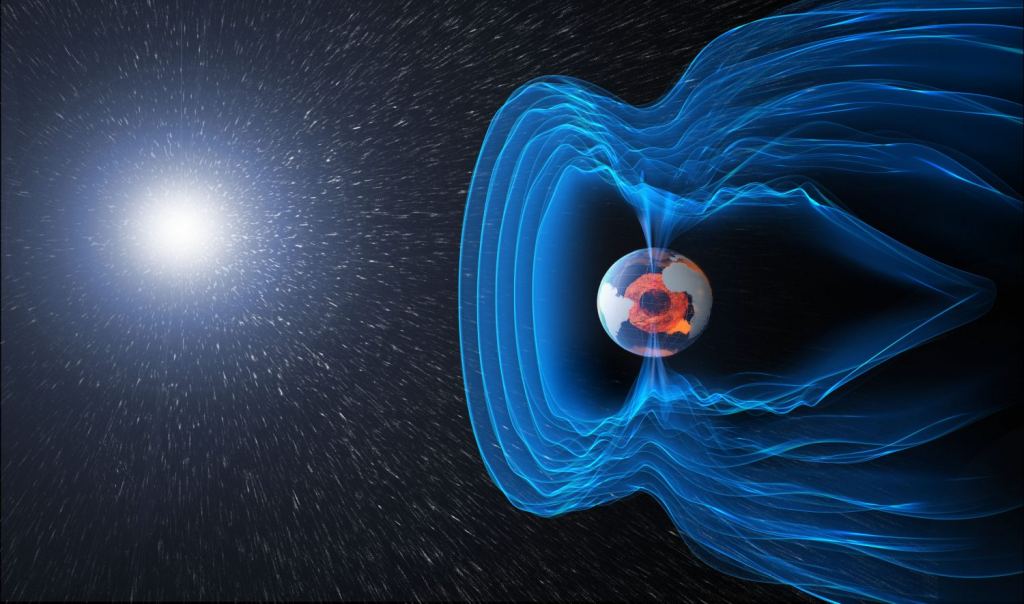A Massive Solar Storm was Detected on Earth, Mars, and the Moon
By Matt Williams
A coronal mass ejection erupted from the Sun on October 28th, 2021, spreading solar energetic particles (SEPs) across a volume of space measuring more than 250 million km (155.34 million mi) wide. This means that the event was felt on Earth, Mars, and the Moon, which was on the opposite side of the Sun at the time. It was also the first time that a solar event was measured simultaneously by robotic probes on Earth, Mars, and the Moon, which included ESA’s ExoMars Trace Gas Orbiter (TGO) and Eu:CROPIS orbiter, NASA’s Curiosity rover and Lunar Reconnaissance Orbiter (LRO), and China’s Chang’e-4 lander.
The ESA’s Solar Orbiter, Solar and Heliospheric Observatory (SOHO), and BepiColombo missions were also caught by the outburst and provided additional measurements of this solar event. The study of Solar Particle Events (SPE) – aka. solar flares – and “space weather” phenomena are vital to missions operating in Low Earth Orbit (LEO) – for example, crews living and working on the International Space Station (ISS). But it is especially vital for missions destined for locations beyond LEO and cislunar space, including Project Artemis and the many proposals for sending astronauts to the Moon and Mars in the coming years.
The event was described in a paper, “The First Ground Level Enhancement Seen on Three Planetary Surfaces: Earth, Moon, and Mars,” that recently appeared in the Geophysical Research Letters. The international team behind it consisted of scientists from the Deep Space Exploration Laboratory (DSEL), the CAS Center for Excellence in Comparative Planetology (CECP), the Institute of Experimental and Applied Physics (IEAP), the German Aerospace Center (DLR), the Space Research and Technology Institute (SRTI-BAS), the Southwest Research Institute (SwRI), the Leidos Corporation, and the Institute for the Study of Earth, Oceans, and Space (UNH-EOS).

The 2021 solar event was an example of what scientists describe as a “ground level enhancement,” a rare occurrence where solar particles are energetic enough to pass through the Earth’s magnetic field and reach the surface. Only seventy-three ground-level enhancements have been detected since scientists began recording them in the 1940s, and no such events have been detected since. While Mars’ thin atmosphere does filter out the lower energy particles (and slows down the highly energetic ones), neither the Moon nor Mars generates similar magnetic fields.
This means solar particles reach the surface regularly and even produce secondary radiation (through interaction with surface regolith). According to measurements made by NASA’s LRO mission from lunar orbit, the solar event was rather weak, equivalent to an absorbed radiation dose of only 31 milligray (mGy) or 31 millisieverts (mSV). Meanwhile, the Exomars TGO and Curiosity rover, obtaining measurements from orbit and the surface, recorded doses of 9 and 0.3 three mGy (respectively) – a difference of a factor of 30.
Compare this to the solar outburst recorded in August 1972, which fell between the Apollo 16 and 17 missions. The measured outburst of radiation from this event would have delivered a fatal dose to any astronauts operating on the lunar surface. Jingnan Guo, a researcher with the DSEL with the School of Earth and Space Sciences at the University of Science and Technology of China (USTC), explained in an ESA press release:
“Our calculations of the past ground-level enhancement events show that, on average, one event every 5.5 years may have exceeded the safe dose level on the Moon if no radiation protection had been provided. Understanding these events is crucial for future crewed missions to the surface of the Moon.”
Astronauts are exposed to radiation regularly when they go to space, but the hazard of prolonged exposure increases dramatically beyond Low Earth Orbit (LEO). This includes the risk of exposure to solar radiation and cosmic rays, which becomes elevated beyond Earth’s magnetic field. But there is also the risk of huge outbursts of SEPs caused by “coronal mass ejections” (CMEs), also known as “solar flares.”

Impact on Astronaut Health
Given how much of our future planned exploration efforts are centered on the Moon and Mars, it is crucial to understand intense radiation events and their effect on the space radiation environment. According to ESA health guidelines, if astronauts absorb more than 700 milligray (mGy) of radiation during a mission – equivalent to 700 millisieverts (mSv) – they may experience radiation sickness caused by the destruction of bone marrow and damage to their central nervous system. This can lead to serious health problems, including nausea, infection, internal bleeding, and elevated cancer risks.
If an astronaut absorbed as much as 10 gray (10,000 sieverts), they would likely die within two weeks. This is why the ESA, NASA, and other space agencies are dedicated to limiting astronaut exposure to 1,000 mSv, or 3% Risk of Exposure-Induced Death (REID), during the entirety of their career. While radiation shielding is important, dedicated instruments that measure the radiation environment in space are used to predict major events. The advanced warning allows astronauts to seek protection within shielded environments, protective suits, and (in the future) lunar or Martian caves.
On the ISS, astronauts and cosmonauts will retreat to designated areas where the wall shield against incoming energetic particles. This includes the sleeping quarters (located in the Russian Zvezda and NASA Harmony modules) or one of the ISS’ galleys in the Nauka and Unity modules. For astronauts bound for the Moon, the Lunar Gateway will serve as the stopover point and a potential fallback position in the event of solar activity. The Gateway will rely on three instrument suites to monitor the radiation environment around the Moon and inside the Gateway. This includes the:
- European Radiation Sensors Array (ERSA) provided by the ESA
- Heliophysics Environmental and Radiation Measurement Experiment Suite (HERMES) provided by NASA
- Internal Dosimeter Array (IDA) provided by the ESA and JAXA
“Currently, we live in a golden age of Solar System physics,” said Marco Pinto, an ESA research fellow working on radiation detectors. “Radiation detectors aboard planetary missions such as BepiColombo, on its way to Mercury, and Juice, cruising to Jupiter, add a much-needed coverage to study the acceleration and propagation of solar energetic particles,”

NASA and the ESA are also developing next-generation space suits to provide improved protection against deep-space radiation, including NASA’s Exploration Extravehicular Mobility Unit (xEMU). The ESA also sent two mannequins developed by the German Aerospace Center (DLR) to space as part of the Artemis I mission, which conducted a circumlunar test flight between November 16th to December 11th, 2022. These mannequins, nicknamed Helga and Zohar, were studded with radiation sensors provided by NASA and the DLR, while one (Zohar) wore a protective radiation vest.
The data obtained during this test flight will help inform future spacesuits developed for ESA crews. Said Colin Wilson, ExoMars TGO project scientist:
“Space radiation can create a real danger to our exploration throughout the Solar System. Measurements of high-level radiation events by robotic missions is critical to prepare for long-duration crewed missions. Thanks to data from missions like ExoMars TGO we can prepare for how best to protect our human explorers.”
Further Reading: ESA, Geophysical Research Letters
The post A Massive Solar Storm was Detected on Earth, Mars, and the Moon appeared first on Universe Today.

August 5, 2023 at 03:41AM
via Universe Today read more...

Post a Comment